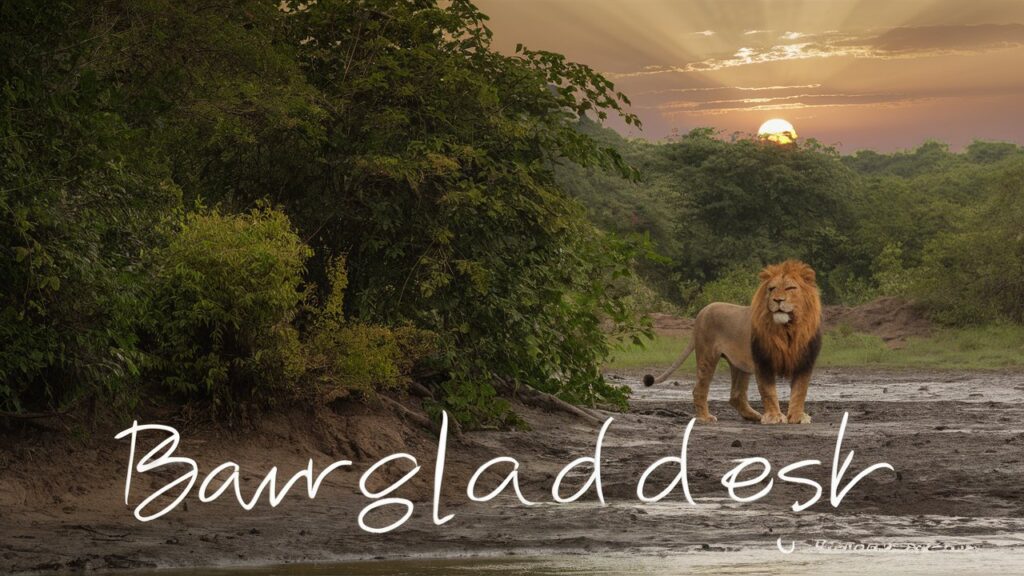There are no lions in Bangladesh. Bangladesh is home to a variety of wildlife, including the Bengal tiger, Indian leopard, wild elephant, saltwater crocodile, and various species of deer, primates, and birds.
The country is located in South Asia and shares borders with India, Myanmar, and the Bay of Bengal. The climate is tropical, with high humidity and monsoon rains from June to September. The Sundarbans, a mangrove forest located in the delta of the Ganges, Brahmaputra, and Meghna rivers, is a UNESCO World Heritage Site and home to the largest population of Bengal tigers in the world.
Despite its rich biodiversity, lions are not native to Bangladesh.
The Myth Of Lions In Bangladesh
Despite popular belief, lions do not inhabit Bangladesh. The country is home to other big cats like tigers and leopards.
| Popular Misconceptions: | Social Media’s Role: |
| There is a common myth that lions can be found in Bangladesh, but this is not true. While the country is home to several large predators such as tigers, clouded leopards, and fishing cats, lions have never been native to Bangladesh. This misconception is often perpetuated through social media and internet rumors. | Social media has played a significant role in spreading the myth of lions in Bangladesh. The rise of fake news and misinformation has made it easier for rumors to spread, leading to confusion and misconceptions about the country’s wildlife. It is important to fact-check information before sharing it on social media and to rely on reputable sources for accurate information. |
Native Predators Of Bangladesh
The Bengal tiger is the national symbol of Bangladesh. Indian leopards can be found in the Chittagong Hill Tracts of Bangladesh. Wild Indian elephants can be seen in hilly areas of Bangladesh. Hoolock gibbon in Bangladesh. The saltwater crocodile is the largest of all living reptiles. No, lions do not live in Bangladesh. Lions are not native to Pakistan. However, a large number of lions, originating from Africa, are kept in various zoos and breeding centers in the country. Apart from Africa, the only place in the world where you can spot lions roaming in the wild is Gir National Park, Gujarat, India.
The Asiatic Lion: Habitat And History
The Asiatic Lion, historically not found in Bangladesh, thrives in grasslands and open woodlands. Other big cats like tigers and leopards roam the country’s diverse landscapes.
| The Asiatic Lion: Habitat and History | |
|---|---|
| Historical range of the Asiatic lion | The Asiatic lion, also known as the Indian lion, historically had a wide distribution across Asia. It was found in countries like India, Pakistan, Iran, and even as far as Greece. However, over time, the population of Asiatic lions declined drastically due to hunting and habitat loss. Today, the only remaining population of Asiatic lions is found in the Gir Forest National Park in Gujarat, India. This small population is highly protected and efforts are being made to increase their numbers and reintroduce them to other suitable habitats. |
| Habitat preferences | Asiatic lions prefer grasslands and open woodlands as their habitat. They thrive in areas with a good prey base and access to water sources. These lions are well adapted to the hot and dry climate of their habitat, with their shorter and lighter manes compared to African lions. They are skilled hunters and primarily feed on deer, antelope, and other ungulates. The dense forests of Bangladesh may not provide the ideal habitat for Asiatic lions, which is why they are not found in the country. However, Bangladesh is home to other big cats like tigers, clouded leopards, and fishing cats. |

Credit: en.wikipedia.org
Comparing Habitats: Lions Vs. Bengal Tigers
Lions are not native to Bangladesh. However, the country is home to other big cats such as Bengal tigers, clouded leopards, and fishing cats.
| Lions prefer grasslands and open woodlands for habitat. |
| Bengal tigers thrive in denser forests and riparian areas. |
The Global Distribution Of Lions
There are no lions in Bangladesh. In Africa, lions roam freely and are a well-known symbol of the continent’s wildlife. However, in India, there is a unique case where lions can be found in the Gir Forest National Park in the state of Gujarat. The Asiatic lion, a subspecies of lion, is native to this region and is an important part of India’s wildlife heritage.
Wildlife Conservation In Bangladesh
Lions are not native to Bangladesh, but the country is home to various wildlife including tigers, clouded leopards, and marbled cats. The Bengal tiger, in particular, is the national symbol of Bangladesh and can be found in its natural habitats.
| Subheading: Efforts to protect native species |
| The conservation of wildlife in Bangladesh is a significant concern. Efforts have been made to protect native species and their habitats. However, there are several challenges in conservation. One of the main challenges is the loss of habitat due to deforestation and urbanization. This has resulted in the decline of many species, including lions. Lions are not native to Bangladesh and are not found in the country. The Asiatic lion, which is found in India’s Gir National Park, does not inhabit Bangladesh. Instead, Bangladesh is home to other big cats such as tigers, clouded leopards, and fishing cats. These native species are also facing threats, and conservation efforts are focused on their protection. Government initiatives, community involvement, and awareness campaigns are crucial in ensuring the survival of these species and maintaining the biodiversity of Bangladesh. |
Introducing Exotic Animals: Case Studies
| Are There Lions in Bangladesh |
| Introducing Exotic Animals: Case Studies |
| African lions in Chattogram Zoo |
| Impact on local ecosystems |
Despite the rich biodiversity, lions do not inhabit Bangladesh. The country is home to various other big cats such as tigers, clouded leopards, and fishing cats. The local ecosystems are vital for the preservation of these species and maintaining a balanced ecosystem. The presence of African lions in Chattogram Zoo raises awareness about wildlife conservation. However, their existence in Bangladesh remains a subject of debate. The conservation efforts play a crucial role in protecting the diverse fauna of the region.
Credit: www.quora.com
The Future Of Big Cats In Bangladesh
The future of big cats in Bangladesh is promising, with a diverse range of species such as tigers, clouded leopards, and fishing cats thriving. However, lions are not native to Bangladesh, with other big cat populations like Asiatic golden cats making their home in the region.
| Conservation strategies: | Educating the public about the importance of preserving habitats. |
The future of big cats in Bangladesh relies on implementing effective conservation strategies. Educating the public about the importance of preserving habitats is crucial for the survival of endangered species.

Credit: www.thepetitionsite.com
Frequently Asked Questions
What Are The Predators Of Bangladesh?
Predators of Bangladesh include Bengal tigers, Indian leopards, wild Indian elephants, hoolock gibbons, and saltwater crocodiles. Lions do not live in Bangladesh.
What Animals Are Native To Bangladesh?
The native animals of Bangladesh include Bengal tigers, Indian leopards, wild elephants, hoolock gibbons, and saltwater crocodiles.
Do Pakistan Have Lions?
No, lions are not native to Pakistan, but some African lions are kept in zoos and breeding centers. Bangladesh also does not have any lions, but other big cats such as tigers and leopards can be found there. Lions are only found in the wild in Africa and in the Gir National Park in India.
Conclusion
While Bangladesh is home to a diverse range of wildlife, lions are not found in the country. However, the presence of other big cats such as tigers, clouded leopards, and fishing cats makes Bangladesh a unique and important habitat for wildlife conservation and biodiversity.



